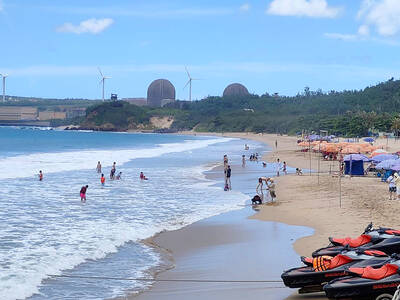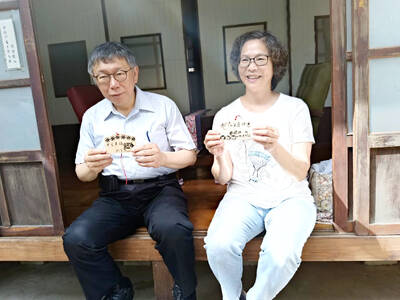More than a hundred shaven-headed men pour out of their Yangon hostel around 6am for a day of weightlifting, karate drills, dancing and Buddhist prayer — drug rehabilitation, Myanmar style.
The group of doctors, musicians and street food vendors set off for a jog around a verdant, orchid-dotted compound, watched over by supervisors carrying heavy wooden sticks.
Welcome to another day at “Metta Saneain” — “the House of Love” in Burmese — a rehab center dishing out tough love to break the cycle of drug addiction.

Photo: AFP
Myanmar has long been a narcotics-producing powerhouse, with drugs fueling and financing decades of internal conflict and authorities turning a blind eye to the billion-dollar industry. The chaos unleashed by the military’s 2021 coup has gutted the legal economy and the country is now the world’s biggest producer of opium and a major source of methamphetamine, according to the United Nations.
Much of the product is smuggled out to other Asian countries, Australia and Europe while scoring on the streets of commercial hub and major port Yangon is easy.
LOST YOUNG MEN

hoto: AFP
Aung, 32, who asked for his full name not to be used for professional reasons, had qualified as a doctor and was running his own clinic when he tried meth for the first time.
Three years later, it had taken over his life, he said, after a breakfast of hot rice porridge cooked and served by another patient.
“I lost everything. It transformed me from a successful person into a lost young man.”

Photo: AFP
He was hospitalized three times before his parents brought him to “Metta Saneain” and its uncompromising regime. Joining in the karate-style drills, tug-of-war competitions and meditation sessions was not easy while he still had cravings, he said.
“At the beginning, it was a bit difficult for me to be here. They are always making us do some activity or other, but later I got used to it,” he said.
“Now I have no time to get bored. It helps me become physically stronger and healthier.”
Angkoon Phattarakorn, a specialist at the Princess Mother National Institute on Drug Abuse Treatment in neighboring Thailand, said tough approaches can help in the short term but they need to be tailored to individual needs.
“If some people have a heart problem, they might not do well if you tell them to do heavy exercises,” he said.
“People with mental problems might not respond well to meditation.”
There are questions over how effective such schemes are in the long run, he added.
“Addicts need proper training to stop using drugs and reintegrate themselves into society, as well as develop the ability to refuse drug temptations.”
After the morning jog, the patients sing the national anthem and prayer is an important part of the daily routine, with both Buddhist and Islamic services provided.
Residents have to wash and clean their own clothes throughout their stay.
An instructor leads one group through a Bollywood-style dance routine of shoulder twitching and hip swinging, prompting shy smiles from the class.
“Drugs are available everywhere now as there are some limitations in controlling them,” said center administrator San Shein, referring to the current conflict.
The facility’s focus on exercise and meditation helps patients to “develop physically and mentally,” he said.
“Some of them have six-packs now.”
The approach has given a new direction to Zaw Wanna, 26, who entered the center to kick his heroin habit four years ago and has stayed on as a supervisor.
When he arrived he was one of around 40 patients, mostly addicted to marijuana, meth pills or heroin.
‘HAPPY WATER’
Now there are more than three times as many patients.
The most common addictions are to ecstasy, ketamine and “happy water” — a mixture that can contain MDMA, tramadol, caffeine, diazepam and ketamine and has proliferated in nightclubs in recent years.
“I sold everything we have at home for drugs,” said Zaw Wanna.
“Now there are many addicts and many parents have been saddened. I want people to quit. I myself was an addict and I regret it now.”
Patients’ relatives pay for their treatment at the “House of Love,” which costs from around 400,000 to one million Myanmar kyat (US$90-$230) depending on their condition.
The facility has rehabilitated 205 people this year, said Khin Khin Win, secretary at the Myanmar Drug Addicts Rehabilitation Association (Central), an umbrella group.
After years of turmoil, Aung is now helping as a volunteer doctor at the center and hopes to pursue a degree in applied psychology.
His family now have some hope for him, he said.
“I don’t want to use anymore. It’s been a scary thing for me.”

Climate change, political headwinds and diverging market dynamics around the world have pushed coffee prices to fresh records, jacking up the cost of your everyday brew or a barista’s signature macchiato. While the current hot streak may calm down in the coming months, experts and industry insiders expect volatility will remain the watchword, giving little visibility for producers — two-thirds of whom farm parcels of less than one hectare. METEORIC RISE The price of arabica beans listed in New York surged by 90 percent last year, smashing on Dec. 10 a record dating from 1977 — US$3.48 per pound. Robusta prices have

A dozen excited 10-year-olds are bouncing in their chairs. The small classroom’s walls are lined with racks of wetsuits and water equipment, and decorated with posters of turtles. But the students’ eyes are trained on their teacher, Tseng Ching-ming, describing the currents and sea conditions at nearby Banana Bay, where they’ll soon be going. “Today you have one mission: to take off your equipment and float in the water,” he says. Some of the kids grin, nervously. They don’t know it, but the students from Kenting-Eluan elementary school on Taiwan’s southernmost point, are rare among their peers and predecessors. Despite most of

The resignation of Taiwan People’s Party (TPP) co-founder Ko Wen-je (柯文哲) as party chair on Jan. 1 has led to an interesting battle between two leading party figures, Huang Kuo-chang (黃國昌) and Tsai Pi-ru (蔡壁如). For years the party has been a one-man show, but with Ko being held incommunicado while on trial for corruption, the new chair’s leadership could be make or break for the young party. Not only are the two very different in style, their backgrounds are very different. Tsai is a co-founder of the TPP and has been with Ko from the very beginning. Huang has

Nine Taiwanese nervously stand on an observation platform at Tokyo’s Haneda International Airport. It’s 9:20am on March 27, 1968, and they are awaiting the arrival of Liu Wen-ching (柳文卿), who is about to be deported back to Taiwan where he faces possible execution for his independence activities. As he is removed from a minibus, a tenth activist, Dai Tian-chao (戴天昭), jumps out of his hiding place and attacks the immigration officials — the nine other activists in tow — while urging Liu to make a run for it. But he’s pinned to the ground. Amid the commotion, Liu tries to